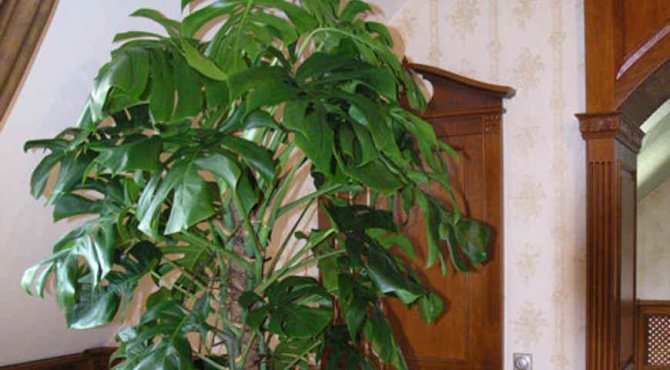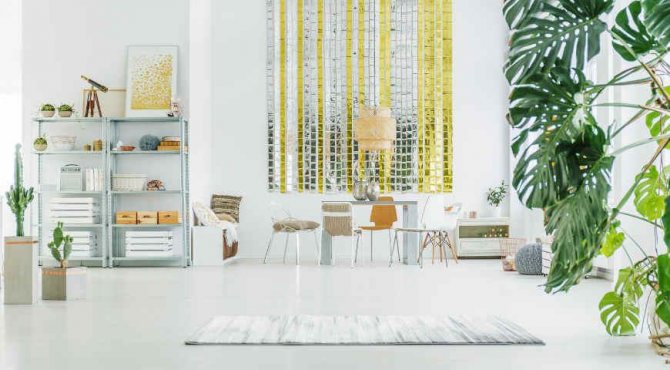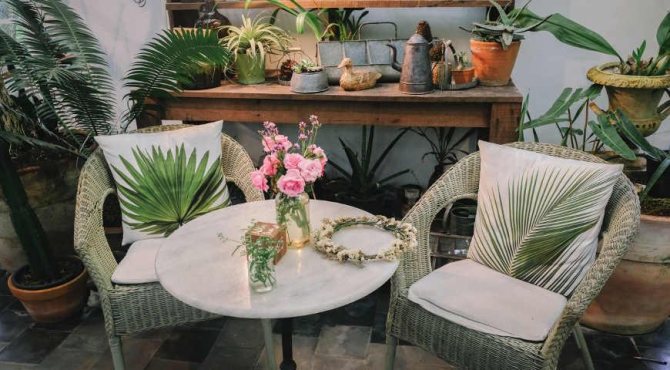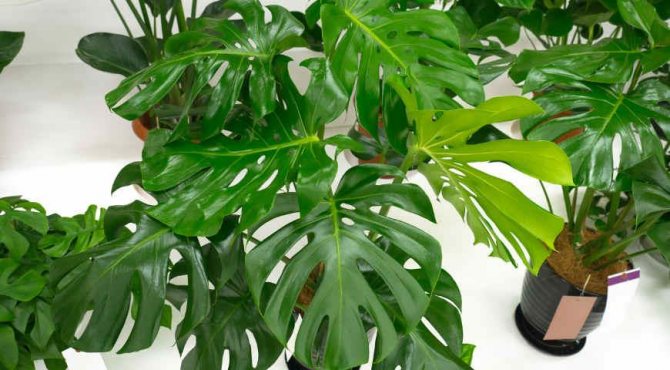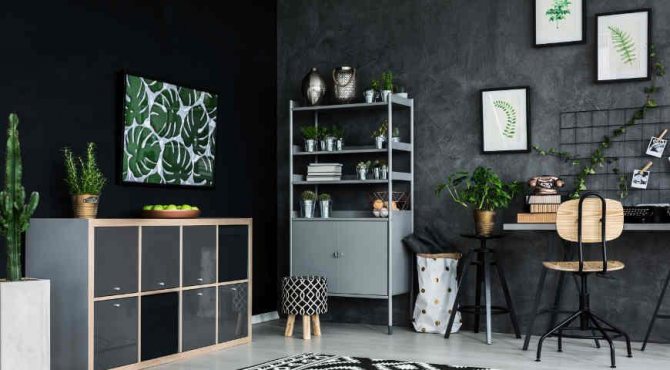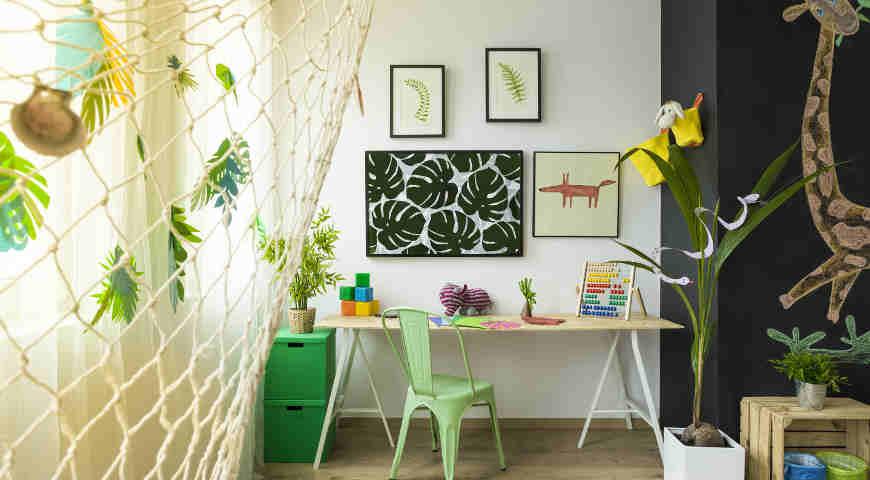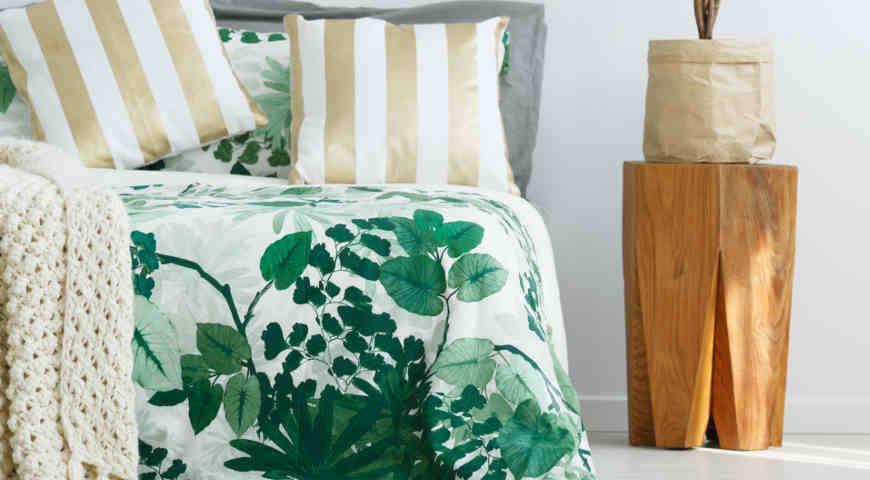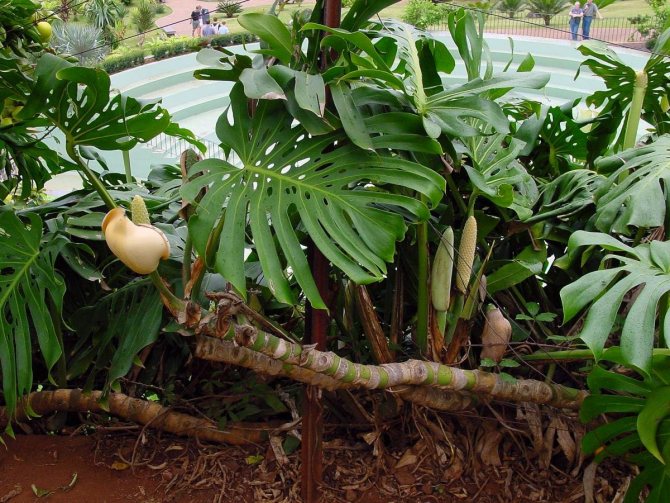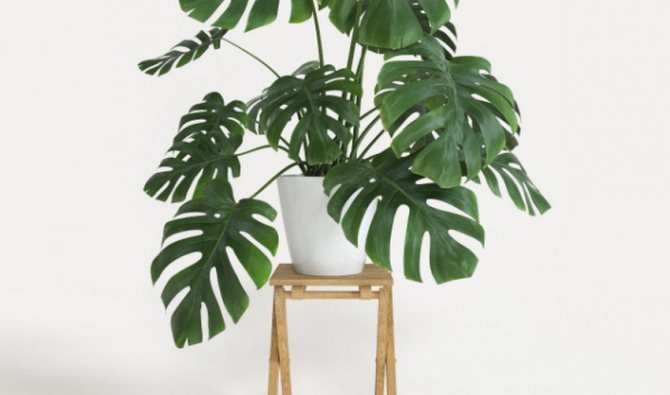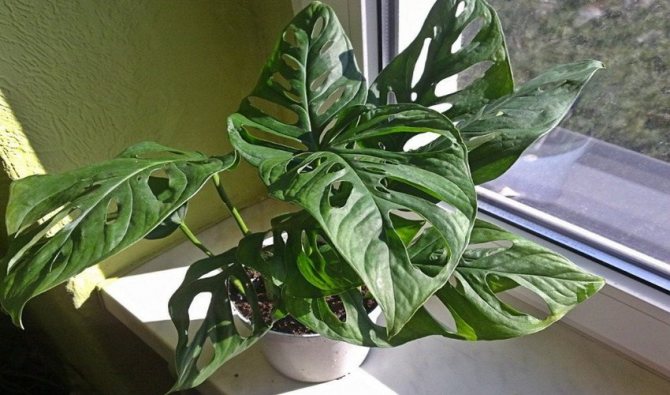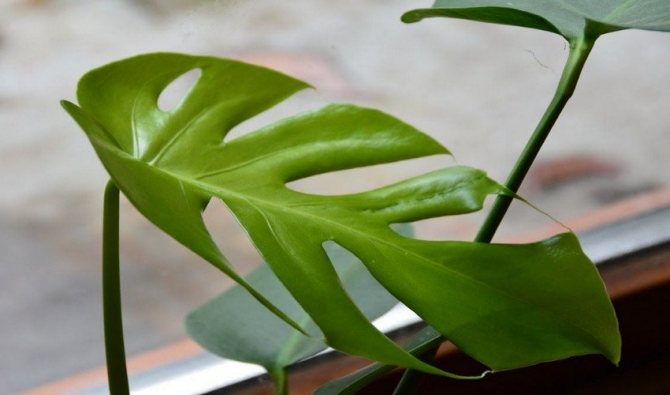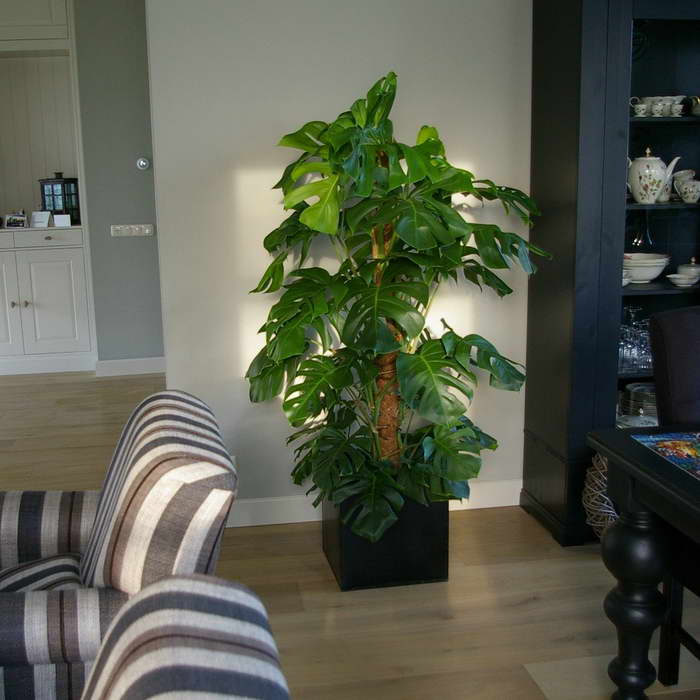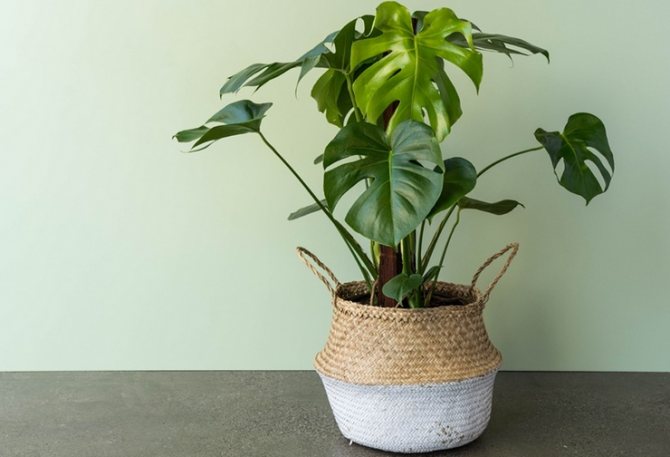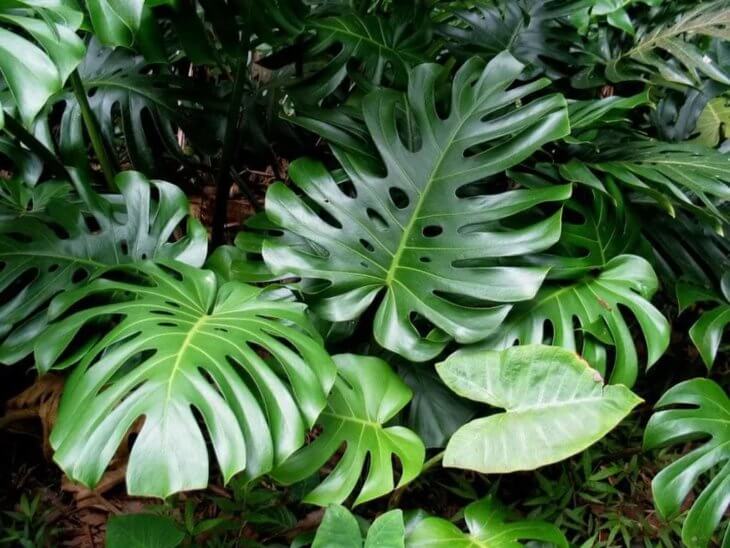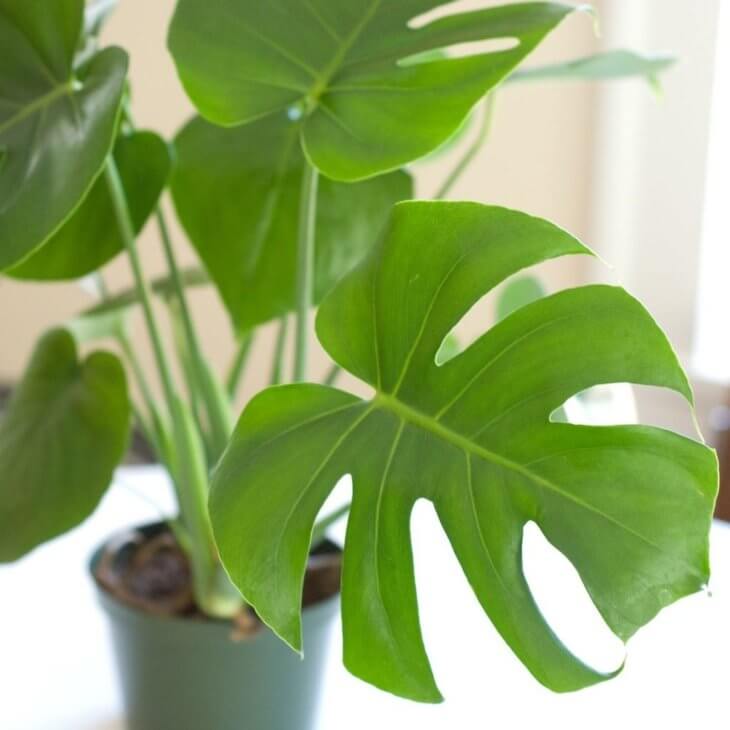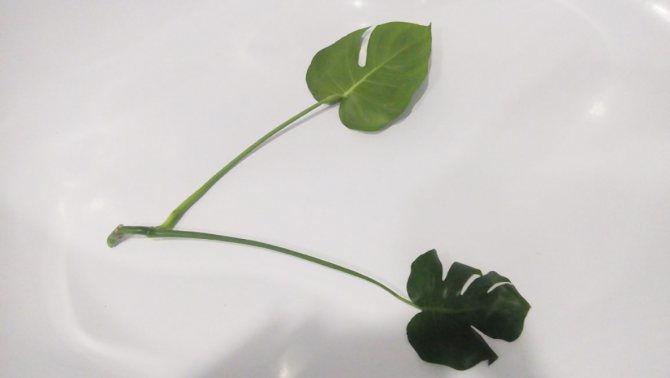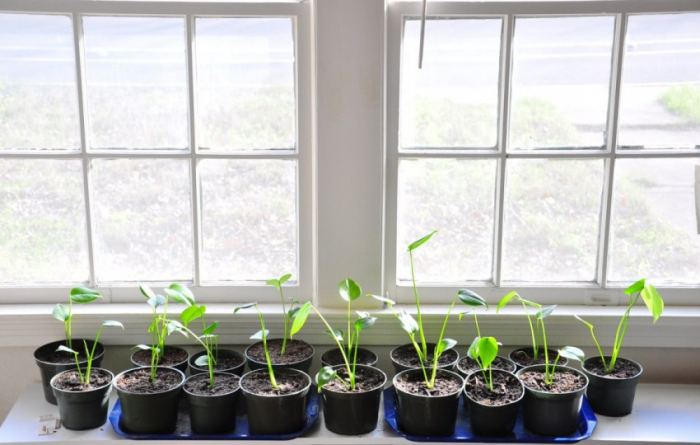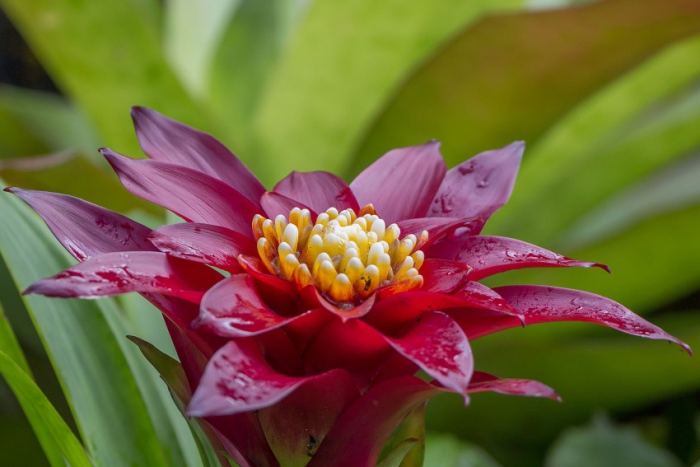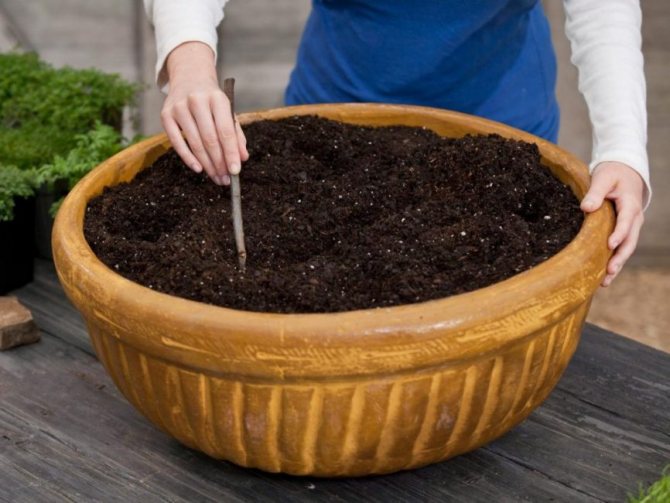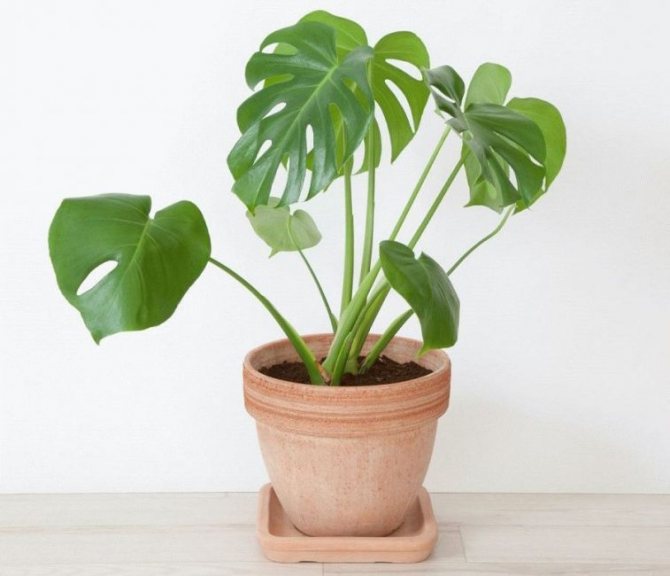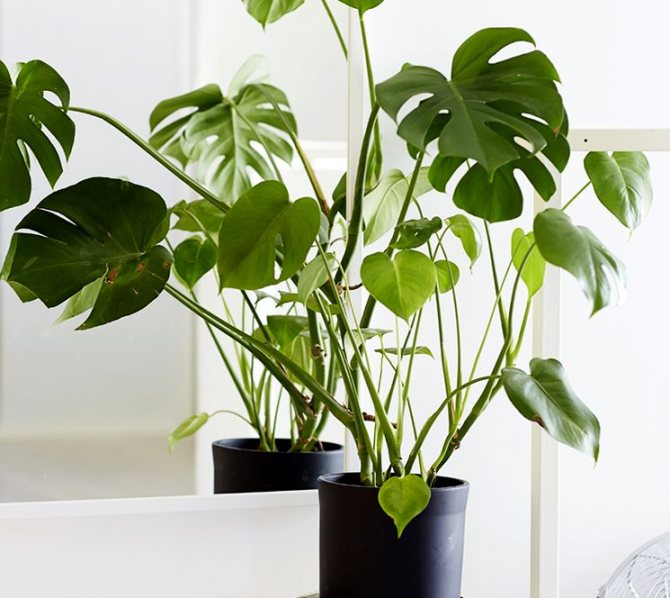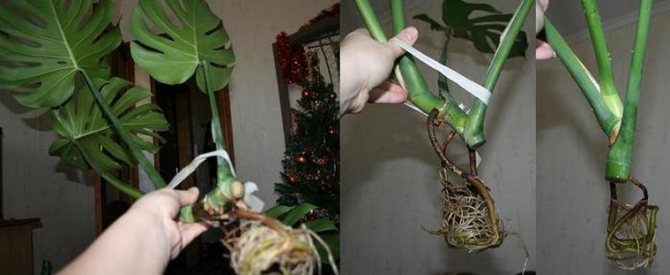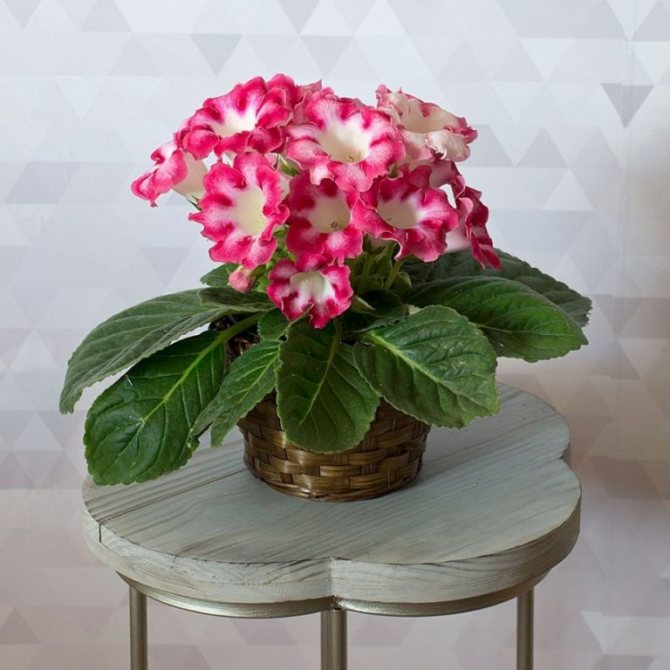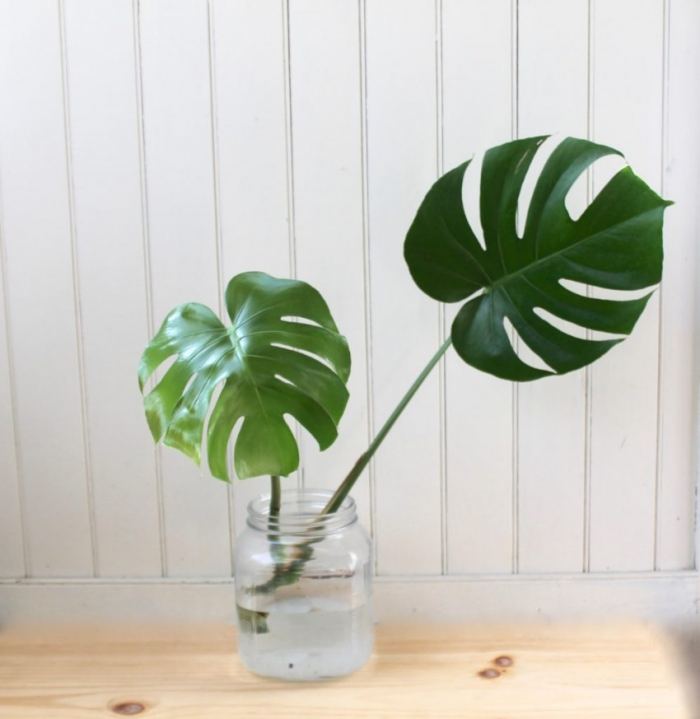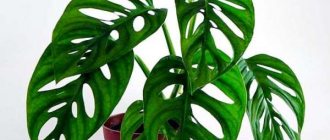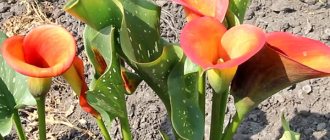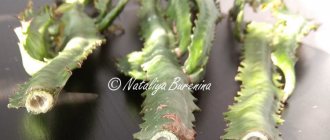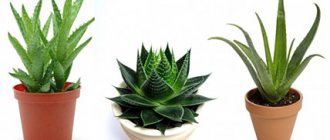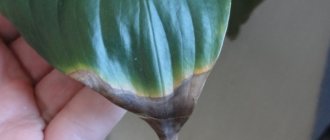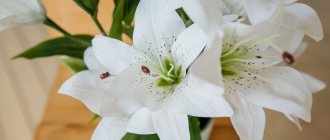Monstera is an exotic plant native to the hot tropics of America, the name of which translates as "unusual", "bizarre", "amazing". It is a long evergreen vine with leaves that can grow up to 1 meter in size.
The flower really looks interesting and mysterious, and there are many different legends about it, and it will also take superstitions. This article will introduce you to them, and also allow you to find out useful information about this curious representative of the green kingdom.
Monster species
Monstera Delicacy
In its homeland, the monstera grows up to several meters, blooms every year and even bears fruit. It will be difficult to create an ideal climate for her at home, and the height of our ceilings will not allow the plant to "unfold". The most popular type, and there are about 50 of them in total, monstera Delicacy
(Attractive).
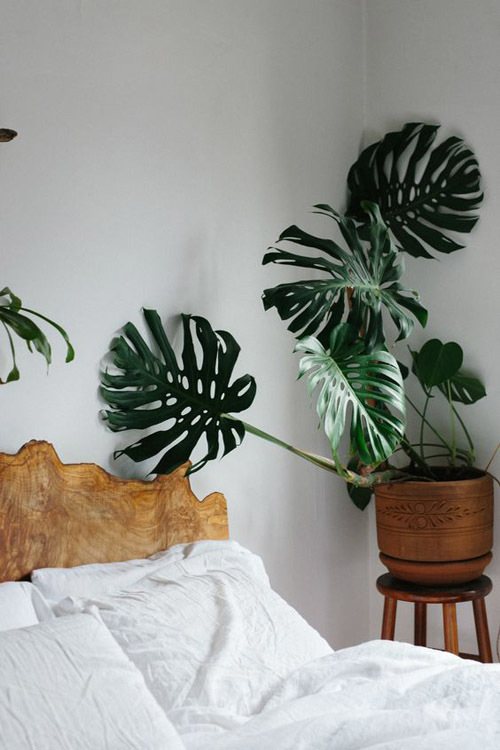
It can grow at home and up to three meters. This species with a telling name just produces edible fruits. The monstera flowers themselves are somewhat reminiscent of calla lilies, and the fruit looks like an ear and tastes like pineapple. But keep in mind, it ripens for a very long time, almost a year, and in no case rush to taste it: an unripe ear can burn your mouth.
Oblique monstera
There are, of course, also compact species - Oblique
monstera
and
Dubious
... The oblique monstera is convenient because it can be grown as an ampel plant, that is, plants grown in hanging pots.
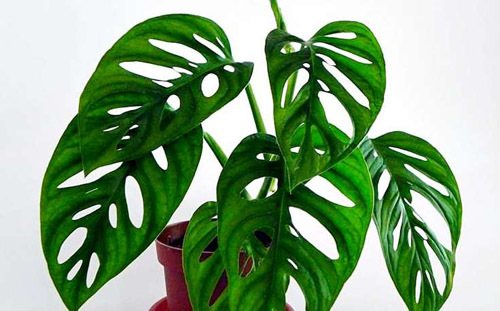

Monstera Punched
The "leaky" views look very nice - monstera punched
.
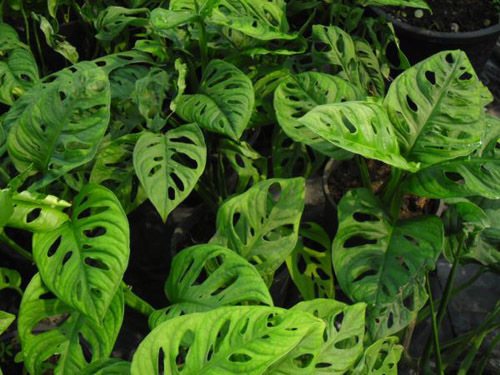

There are also bred variegated plants with white and green leaves.
Folk beliefs
The most popular ones are:
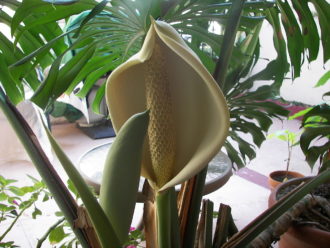

- Monstera is an energy vampire and sucks strength from a person, thereby destroying his life and spoiling his health. It can also suck energy out of pets.
- The plant should never be placed near the bed. - it can provoke suffocation, nightmares and even death.
- Monstera upsets the harmony in the family, because of which the spouses will constantly quarrel, which can even lead to the destruction of the marriage.
- A monster cannot be kept in a house where an unmarried one lives girl or woman - this flower repels men and prevents her from starting a serious relationship.
Caring for a monster at home
Although experts say that the monster is easy to grow, and it is completely unpretentious, they are cunning. You will not get off with simple watering.
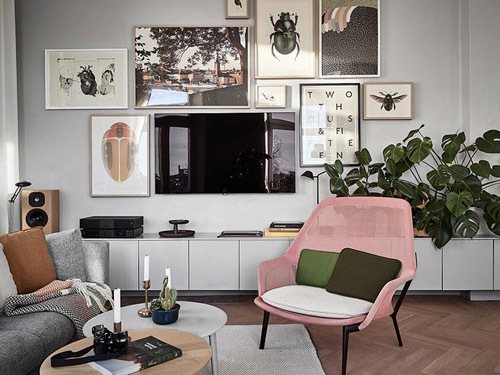

Monstera likes diffused light, so do not put the pot in direct sunlight by the south window. But keeping it completely in the shade is harmful. Although she is shade-tolerant, she will have to provide her with additional lighting.
Highly temperature conditions are important
... Although it is a tropical liana, it does not like the heat, so keep it away from the batteries in the cold season, and do not put it under the air conditioner in the summer. The ideal temperature in summer is 18-25 degrees. It's good if you let her breathe - small flowers can be taken out, for example, on the balcony. In winter, it is important to provide a cool regime of 16-18 degrees or slightly lower. Of course, at home without glazed and insulated balconies this is impossible, but don't worry, the monstera will survive our heating season if you provide sufficient air humidification. Here, an air humidifier or at least regular spraying will help you.It is also helpful to wipe the leaves with a damp cloth and even polish. Although the latter is more for beauty.
Water the monstera often in summer, moderately during the cold period. The main secret here is that it is necessary to water when the top layer of the earth has dried up by about 1/3 of the pot, otherwise you risk flooding the flower and getting rotting roots.
How can it be dangerous?
Negative associations with the monster appeared due to its frightening appearance, resembling a predator or monster, the name consonant with the word "monster", and the fact that it grew on the skeletons of dead people, allegedly causing their death. Contrary to false fears and prejudices, this representative of the green kingdom is not at all dangerous and poisonous, it can be safely kept at home.
The only one the danger is posed by small needle-like processes (raffids) on the leaves of the plant - they are poisonous, therefore, they can cause irritation, burning and allergies in the one who touches them or eats them. Because of this, the flower must be placed in a place where pets and small children cannot get it. For the rest, the monstera is no more dangerous than others, and in Asia its fruits are even eaten.
Reproduction at home
You can grow a monster yourself from seeds, but more often it is propagated by shoots and cuttings. So, if you have found the ideal place and created what is called "all conditions", then another pitfall awaits you - a transplant. I recommend replanting a young monster every year. The further, the, of course, less often: from 3-4 years old every 2 years, from 5 years old every 3-4 years. But if the monstera does not grow very much and the pot, which is called at the time, then once again do not disturb her. In the year that you do not replant it, simply renew the top of the ground.
Reproduction methods
Monstera can be propagated in several ways.
Cuttings
The procedure is carried out in the spring, during the period of active growth. Lateral shoots, apical or stem shoots are suitable. As a cutting, the shoot is carefully cut, on which there are 1-2 leaves.
After planting in an individual flowerpot, the container is covered with glass to retain moisture. The soil is nutritious, with an obligatory layer of humus or peat and good drainage. Temperature - from +20 to + 25 degrees, watering in the morning or evening, so that the substrate does not dry out too much. The rooted stalk is transplanted into a clay or plastic container with holes in the bottom. After three to four years, a new transplant is carried out.
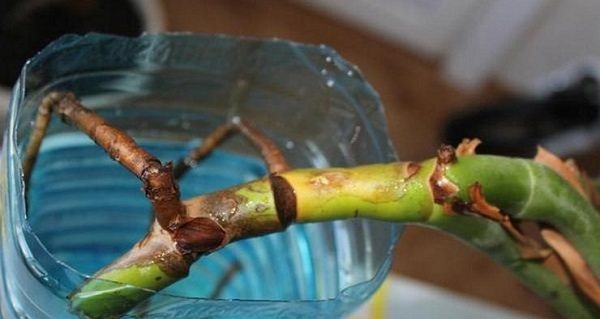

Air roots
Aerial roots are often formed on large leaves. The leaf plates from below often fall off, and there is a possibility of rooting of filamentous processes. The two upper roots are wrapped with moistened sphagnum moss, attached to the trunk, and the roots are waiting for lengthening.
The next step is to cut off a part of the trunk with one or two leaves, sprinkle the separation zone with activated carbon. The shoot is placed in a pot with a nutrient substrate, grown as usual. In an adult plant, lateral shoots appear, the splendor of the bush increases.
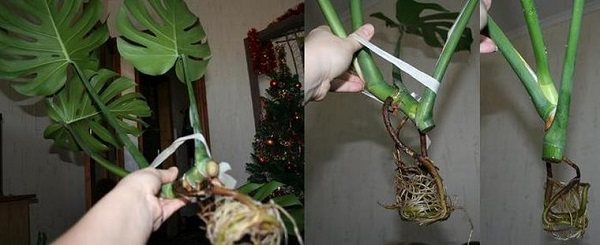

Seeds
The process takes a long time. The seeds of a decorative leafy specimen are placed in the ground (the composition is the same as for an adult plant), removed on the windowsill, where it is warm, light and there are no drafts. Seedlings appear no earlier than a month later. Seedlings must dive: they are moved to individual containers.
The first leaves do not have an openwork decor, “real” leaf plates are formed about six months later and later. Monstera from seeds grows slowly: in a couple of years on the bush there will be several juvenile leaf plates (without holes) and three or four "real" ones (with slots).
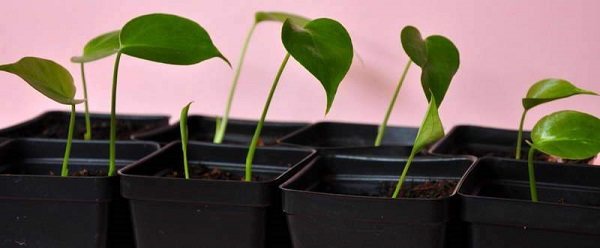

Pest control
Even a monster like a monstera is powerless against pests and can become infected with scale insects, thrips, spider mites and mealybugs. There is no need to be afraid of them, and the control measures are the same as for other plants.The leaves are first washed, preferably with soap and sprayed with an insecticide. It is worth choosing less toxic ones. A small plant can still be taken outside and sprayed, and a three-meter plant will have to be treated at home.
So, if you are not scared by all the difficulties of growing a monster, feel free to start it. Still, a piece of the tropics at home will brighten up the expectation of spring and vacation. And as a bonus - the monstera ionizes the air and is able to predict the weather. It turns out not such a monster.
The benefits of a flower
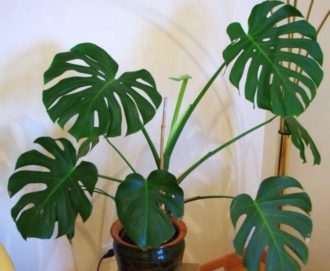

There are also positive signs, especially common in the East, which are associated with the monster. For example, it is believed that this the plant (like others, having large leaves) serves as a talisman and keeper of the hearth: attracts good luck and wealth to the house, does not let bad people in and contributes to the longevity of its inhabitants.
Due to its property of an energy "vacuum cleaner", this representative of the flora can be beneficial, since it takes away negative energy and can give back positive energy.
From a scientific point of view, the monstera has the following beneficial qualities:
- produces oxygen, purifies, enriches and humidifies the air;
- absorbs formaldehyde (it is contained in building and finishing materials) and small particles of debris, dust and dirt;
- secretes special substances phytoncides, which have antibacterial and antimicrobial effects, prevent the spread and growth of fungi, viruses and other microorganisms;
- reduces the level of electromagnetic radiation from household appliances;
- acts as a natural barometer - before precipitation, small drops of moisture appear on the leaves of the plant.
Among other things, monstera is just a beautiful and picturesque plant that will revitalize the interior of the house and make it cozy.
Monstera in the interior: photos and ideas
Monstera is one of the most popular indoor plants for Scandinavian style lovers. Nowhere else have we seen such an abundance of these green monsters. They go well with light walls, gray furnishings and geometric Nordic prints.
If you like this plant with its huge carved leaves, but do not want to grow at home, then the tropics can always be added to the interior with the help of prints. Try posters, throw pillows, bedding, or even wallpaper. The main rule is not to overdo it. If your interior is made mainly in calm colors, without patterns and ornaments, then feel free to take green leaves as a decor.
Can the plant be kept at home? Why is it considered that it is impossible?
Contrary to warnings and fears, the monster can be kept at home, because it is the most common indoor plant. It consumes no more oxygen than other indoor plants and the person himself, so it is quite possible to put it in the bedroom and no suffocation will happen.
Fears are mainly associated with negative omens and superstitions. (which have already been listed), so you should not take them seriously and be afraid of the monstera.
Dormancy and flowering period
Monstera is an evergreen without a pronounced dormant period. When the daylight hours decrease and the ambient temperature drops below +20 ° C, it slows down its growth. In addition, in winter it does not need fertilizers, and watering becomes more scarce. Such a period gives the liana a respite and the opportunity in the spring to begin to develop rapidly again.
In nature, the plant blooms with large, up to 30 cm tall, white or light cream flowers, reminiscent of corn cobs. Unfortunately, this practically does not happen in the home. Only occasionally flowering and fruiting can be achieved in large greenhouses or conservatories.
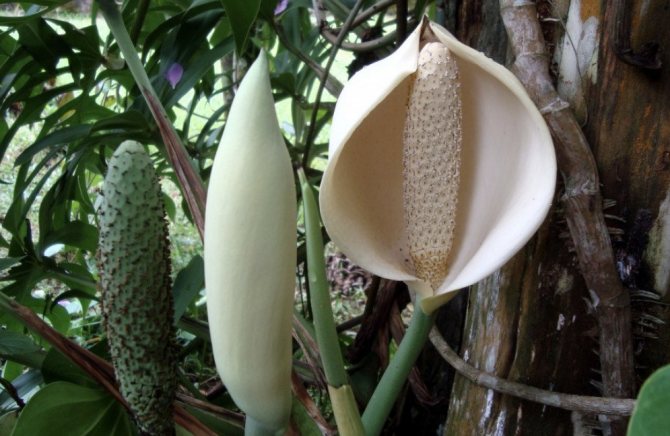

Approximately 8-10 months after flowering, monstera fruits are fully ripe.Its berries are edible, which is reflected in the name - gourmet or delicious monstera.
Pests, diseases, possible problems - table
Diseases and pests rarely affect the vine, but sometimes they become the cause of its death. The plant can curl, fall off, turn yellow and dry the leaves.
| Plant diseases | External signs | Control methods |
| Chlorosis (carried by aphids and ticks) | Yellowing of leaves, the appearance of light spots. | Phyto-farm processing. Top dressing. Compliance with cleanliness. |
| Root rot | Yellowing and wilting of leaves. | Regulation of the irrigation regime. Removal of rotten roots with charcoal sprinkling of the cuts. |
| Spider mite | The appearance of dots and spots of yellow color on the sheet plates. Falling leaves. The presence of a white web. | Treatment with phyto-farm or derris. Regular shower with warm water. |
| Aphid | Curling, deformation and drying of young leaves. | Treatment with insecticide against aphids and preparations with permethrin. |
| Shield | The appearance of hard brown plaques on the back of the leaves, drying of the tips. | Repeated treatment with a damp cloth with soapy water and insecticide. |
Potential harm
There are many opponents of the flower who consider it dangerous. If you belong to this type of people, then it is better to refrain from buying this house plant. This will not give reason to think that the vine is capable of harming you and your family. Scientists cannot yet unambiguously answer the question of whether it is possible to keep and grow a monster at home. Everyone must decide for himself whether or not to do it.
Some particularly impressionable personalities are sure that this vine is an energy vampire. An indoor flower supposedly can not only absorb the forces and energy of our body, but also disrupt the aura and karmic body of a person, and this leads to the emergence of failures in career, love and, in general, fate. Therefore, some unmarried young ladies relate to this particular plant with a great deal of skepticism.
Monstera (flower): impact on humans
Is it possible to keep an orchid at home: options why it is good or bad
Does monstera have an impact on humans — a question that arises for florists before buying. The plant is considered an energy vampire that absorbs the good energy of the owners and can negatively affect the aura in the house. In fact, the monstera will only bring benefit and joy to the house.
Flower myths about the impact on people
Each flower has its own history, legends associated with it. There is a myth that travelers in tropical forests saw how the plant fed on human flesh, after strangling people with its long roots. In fact, the roots could have entwined long-dead bodies and skeletons.
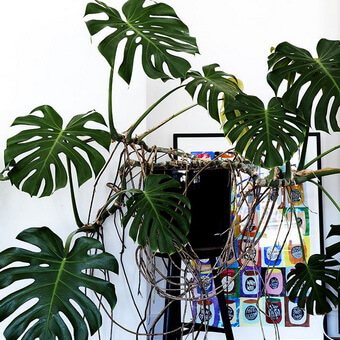

Philodendron roots
Note! Many people are afraid to sleep in a room with a monster, knowing about its ability to absorb large amounts of oxygen. The flower will suck out all the oxygen, and a person will not be able to wake up in the morning. Philodendron absorbs only harmful impurities in the air and releases even more pure oxygen.
The opinion that the plant emits negative energy, which leads to problems in family and personal relationships, career, failures, etc., is also considered a myth. It is better for dubious growers not to start a monster, since they will blame the occurrence of all their problems on her. The plant will feel a negative attitude towards itself and will not be able to exist in such conditions.
Beliefs about the flower of other peoples
According to feng shui, the ancient Chinese science of the flow of energy, a flower helps to achieve calmness, tranquility, harmony. It will help its owner achieve success at work and career growth. Chinese teachings claim that the plant combines the masculine Yang and the feminine Yin, which reduces the flow of erotic energy. Therefore, the monstera is not placed in the bedroom of a married couple.
Among the peoples of Southeast Asia, the plant is a symbol of happiness, health, longevity, good luck, prosperity.Monstera in the house stands specially at the bed of a sick person. Also, the pot is placed at the entrance to the house, it is considered the keeper of the hearth, not letting negative energy into the house.
For your information! In Australia and India, questions about whether a plant is poisonous disappear. In these countries, it is eaten with great pleasure and is even specially grown for human consumption. The fruit of the flower is considered a particularly delicacy dish.
Housekeeping conditions - table
| Parameter | Spring Summer | Autumn winter |
| Temperature | Up to 28 degrees Celsius | Preferably up to 20 degrees |
| Humidity | Requires constant spraying | |
| Lighting | North, east, west window or in the back of a room with a south window | |
| Watering | Frequent, keeping the soil moist | Moderate, especially at low temperatures |
Since the homeland of vines is the humid tropics, then for successful cultivation and the greatest decorativeness, it is necessary to create just such conditions: humidity, diffused light and heat, and then, with proper care, the monstera will live with you for several decades.
Origin and distribution
The plant belongs to the genus Monstera of the Aroid family. About 50 species of this plant are known, but the most widespread is the attractive monstera, which is also called the gourmet monster. It is she who can most often be found in our houses, apartments, cultural institutions and office premises.
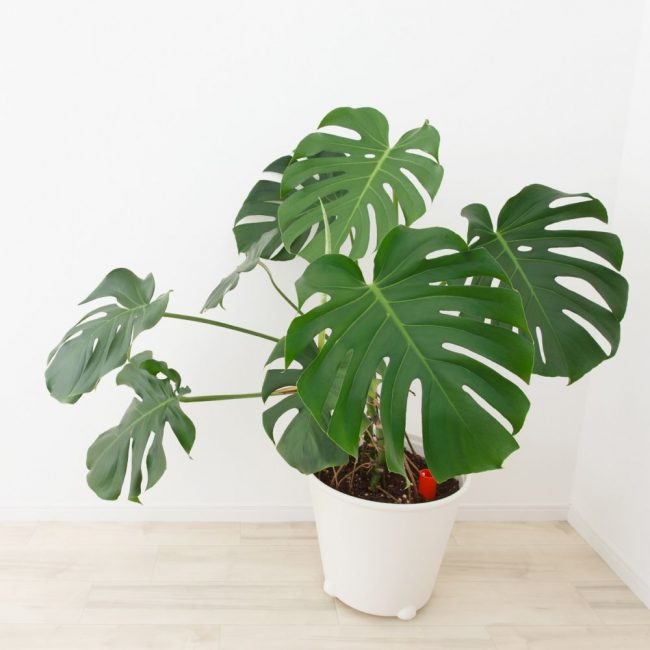

Monstera has an unusual appearance
The rainforests of Central America are home to this magnificent large liana with a thickened stem and airy adventitious roots. In the wild, it grows in the hot and humid tropics of Mexico, Panama, Guatemala and Costa Rica.
Gradually, this vine spread in Asia and Australia, where it was cultivated for the sake of obtaining edible fruits. In temperate regions, monstera is grown as an indoor ornamental deciduous plant indoors, in greenhouses, greenhouses and conservatories.
back to menu ↑
Read also: Geranium: description, types, home care, cultivation, reproduction, pruning and other useful information (50+ Photos & Videos) + Reviews
How to transplant to a monster after purchase
You bought a small plant from the store with two or three small leaves. It bears little resemblance to those giants that have leaves about fifty centimeters wide and more. But don't despair. Very soon, large glossy leaves with fanciful cuts will decorate a room or office. In the meantime, you need to transplant the monster from the shipping store plastic into a beautiful pot. To do this, you need to prepare the ground in advance. Many hobbyists prefer to buy ready-made potting mix.
All work should be carried out with gloves, since monstera juice is irritating. The young plant is transplanted in the usual way, since it has no aerial roots to damage.
Why do monstera leaves turn black
Monstera turns black due to stagnant moisture in the pot, which can be caused by insufficient drainage and / or over-frequent, heavy watering. The root system begins to rot, the rot spreads to the entire plant.
An emergency transplant with soil replacement and fungicide treatment is required. Free the roots of the plant from the soil, cut off the rotten ones, and plant in a disinfected pot with fresh soil. Be sure to add a drainage layer of small stones to one third of the pot. After transplanting, pour a solution of phytosporin and treat the leaves with it.
Botanical description
Monstera is a large evergreen plant of the Aroid family. The natural habitat is Central, South America, found in Asia. In translation, the name of the plant means "bizarre".This is a vine with a thick climbing stem, which is covered with air roots.
Plant height reaches 5 m. Large leaf plates are attached to long petioles. Young leaves are whole, then holes and cuts appear on them, they become dissected into several lobes. The inflorescence is a cob surrounded by a veil.
Feng Shui Monstera
Feng Shui, which is designed to create a favorable space and harmonize the environment, endows the monster with an excellent property to streamline a person's thoughts, to be more decisive. Therefore, it will look great in the office, not only decorating it, but also contributing to successful negotiations and better work - its place in the office of the manager, the meeting room.
Where the monstera stands, there is no chaos. She is able to align the energy of space, with her help you can achieve harmony, calm down. The influence of the monstera on mental abilities is extremely positive.
It is believed that monstera unites yang and yin, masculine and feminine - therefore, it does not contribute to a harmonious relationship, as it reduces libido. For this reason, you should also not put the monster in the bedroom. Ideal if the monstera is in the hallway, kitchen, dining room or living room. It is also good to keep the monster at home in the office for the same reasons as in the office.
What soil does monstera prefer?
Judging by the reviews, the "Palm" earthen mixture is excellent for planting this plant. However, if it is not possible to purchase it, you can prepare the soil yourself from four different components. To do this, you need to mix one part of coniferous, leaf and peat land, as well as half of the sand. A good drainage layer is required. It is in such a soil mixture that the monstera will feel comfortable and delight with intensive growth, of course, with proper care.
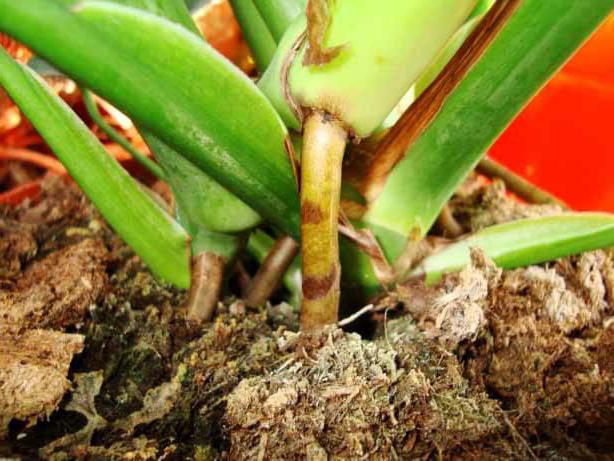

Basic rules for growing
Despite its exotic origin, monstera is quite easy to grow and unpretentious to care for. However, for healthy growth, it requires compliance with certain conditions:
- Lighting. A tropical guest needs bright, but not direct lighting. She is equally negative about shade and direct UV rays. In the first version, its leaves stop developing and do not form cuts, in the second, they dry up and become covered with yellow spots. In winter, it is recommended to install artificial light sources to ensure the required amount of light.
- Temperature conditions. Since the plant is native to the tropics, it prefers to grow in a warm microclimate with a temperature range of + 22–25 ° С in summer and + 17–22 ° С in winter. It is strictly forbidden to keep the vine in drafts.
- Watering. The flower needs frequent and abundant watering, especially in spring and summer, when the phase of intensive development starts. It is also recommended to spray the leaves with water or wipe with a damp cloth on a weekly basis.
- The soil. The soil mixture for the considered ornamental culture should consist of the following components: peat and turf soil, humus and river sand. Mandatory presence of a drainage layer.
- Top dressing. Like any decorative flower, monstera needs systematic feeding, in the role of which mineral fertilizers and organic compounds intended for lianas are excellent. It is imperative to feed the tropical vine in the period from March to August, when there is a time of active growth.
- Pruning. It is not a mandatory procedure when growing a tropical beauty. To form beautiful lush forms, it is enough for a young plant to cut off the top at the initial stage of its growth, which, in order to avoid infection, should be treated with charcoal.
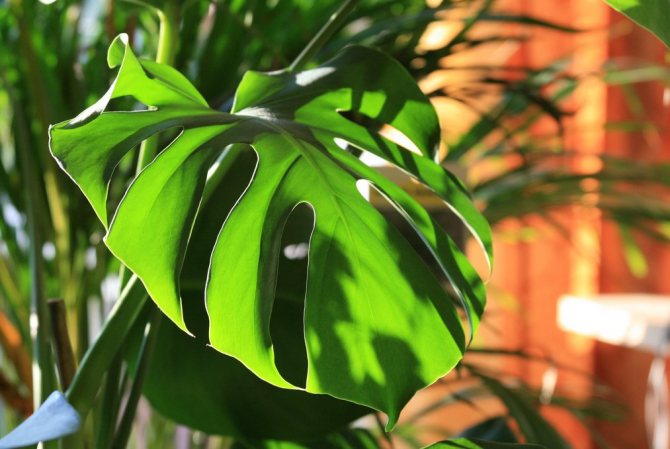

Plant with openwork leaves
Monstera is a typical representative of the South American tropics. In the wild, this vine grows up to 50 meters.And its carved leaves reach a meter in width. To climb trees, the vine grows strong aerial roots, they, descending from the branches, reach the ground. If the monstera has lost contact with the soil, thanks to the air processes, it will fix on the trunk where it lives and become an epiphyte (a plant without soil).
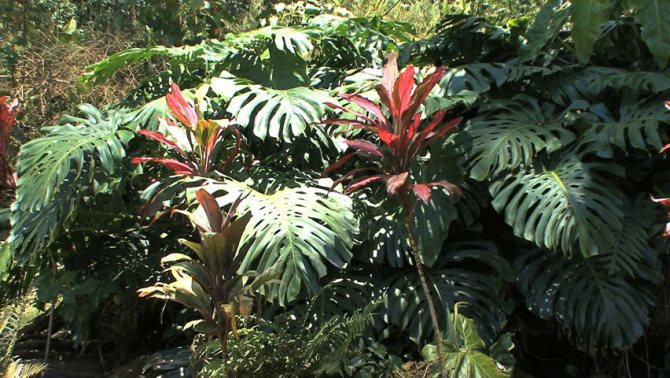

Monstera is a typical representative of the South American tropics, the length of the vine can be 50 meters
Monstera leaves, large, shiny and leathery, deserve special attention. They are located on long stalks and are equipped with an amazing "cut" pattern. They have gracefully cut edges, and sometimes neat symmetrical holes seem to be punched. Not only the appearance of the monster foliage is interesting, but also its internal structure. The lateral veins of the plant are equipped with special organs - guides. With increasing humidity, they emit droplets of a transparent liquid. The monstera seems to be crying. It has long been noticed that crying begins before the rain. So monstera is a natural barometer.
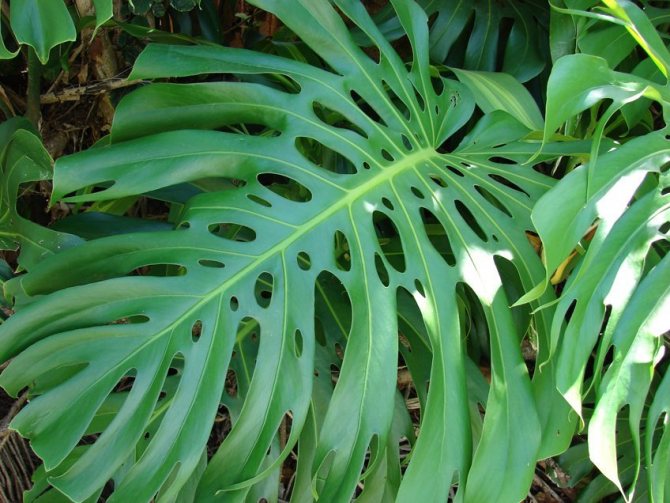

Monstera has gorgeous leaves with delicately cut edges and neat holes.
In natural conditions, the liana blooms. A large (30 cm) yellowish, cream or lilac inflorescence is very similar to an ear of corn, covered, like a blanket, with a petal.
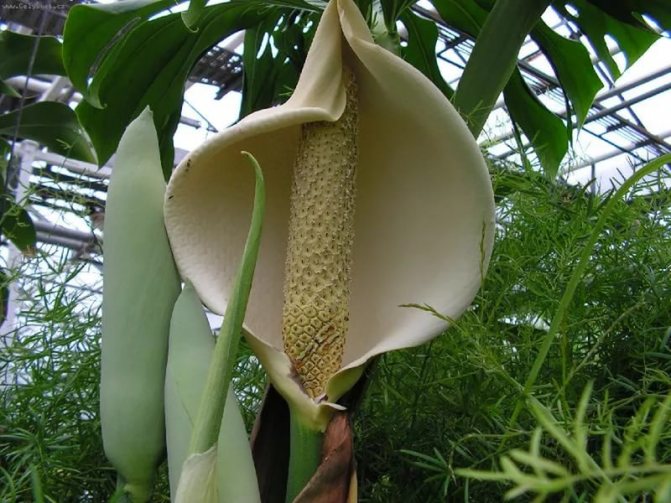

Monstera inflorescence looks like an ear of corn
The monstera fruit ripens for almost a year. A variety of plants called a delicious ripe cob is edible, inside its juicy pulp, its taste resembles something between a banana and a pineapple. But in captivity, monsters rarely bloom and do not bear fruit.
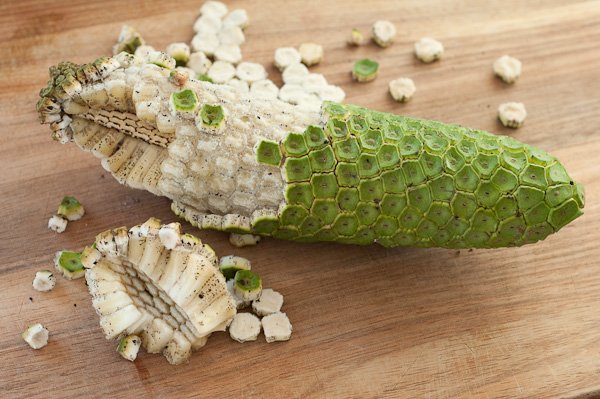

In our area, you will not taste the monster, and the inhabitants of South America grow liana because of its juicy and fragrant fruits.
Monstera is often confused with the split-leaf variety of philodendron. These plants are the closest relatives, they are from the aroid family. But the leaves of the philodendron are more elongated and pointed at the end. The most important difference between monstera and philodendron is juice. If you want to make sure which plant is in front of you, break off or cut a shoot or leaf. The monstera has a clear juice, and the philodendron has a milky one.
Planting, transplanting, pruning, support
When planting a plant, you need to pay attention to the soil. It should be loose, neutral. There are several mix options:
- take one part of humus, peat and sand and add 2 parts of turf;
- mix one part of bark, leafy earth, peat, moss and ½ part of coarse sand;
- add coconut fiber or perlite to the purchased soil for Saintpaulias.
Young vines should be replanted annually as they grow very quickly. The pot should be 2-3 cm larger than the old one. It is better if its height and diameter are approximately equal. In cramped dishes, the leaves can turn brown, thin like papyrus.
The soil, drainage material and container must be sterilized beforehand. The drainage should take up about a fifth of the volume.
The plant must be transplanted carefully, along with a lump of earth. Dry damaged roots must be pruned. The vine is placed in the middle of a new container, covered with earth and lightly tamped.
Adult vines are transplanted after two years. You will need large enough flowerpots. It will depend on them how large the vine will be. The new container must be larger than the old one for the root system to feel comfortable.
Since the plant is large enough, it is better to transplant it together. Transplant step by step.
Transplanting a very large monstera is difficult, so over time, only the top old layer of soil is changed with the addition of humus. If you don't want such problems, you can start a mini plant.
A young monster definitely needs support, as it curls. In addition, the vine will look more attractive. It is put in a permanent place and sprayed. For an adult plant, you can make the support yourself.Sticks with coconut fiber are not a very suitable option, since it is difficult for liana to gain a foothold. To make a support, you can take a piece of a plastic tube that is longer than the plant, drill many slots in it. Next, set it in a pot and pour sand inside to the surface of the soil. Top it up with moss mixed with peat. The support is wrapped in wet moss, on top with a mesh with cells and fixed with fishing line. This design also needs regular spraying. Other options are possible.
The plant grows air roots, but they cannot be removed. If a liana winds along a moss tube, then the roots will grow into it themselves.
When an adult plant stops growing intensively, you can cut off its top for rejuvenation. The cut should be sprinkled with charcoal. This procedure promotes the growth of side shoots, crown formation.
Construction of an additional support for the monstera
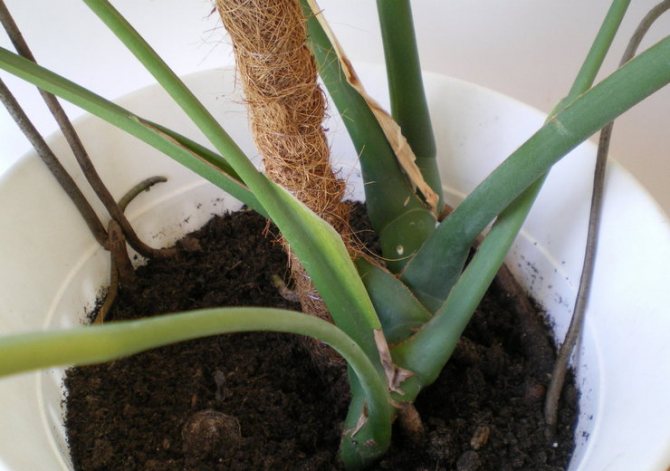

Since the monstera plant is large and weighty, it will definitely need a support that will hold the flower. It is placed in a pot when transplanting a plant next to the trunk so that the lower part of the support is at the bottom of the pot. It can be a tube or a pole wrapped in coconut fiber.
A beautiful liana can be held on one vertical support or on several horizontal ones. With vertical support, the monstera looks like a tree, and you can use it (support) on a small area and in a medium-sized container. In spacious rooms for an adult flower in a large wooden tub, you can make several supports that will direct the plant horizontally and slightly raise it above the surface, and its aerial roots will hang down in the form of a green fence.
Transplantation - highlights
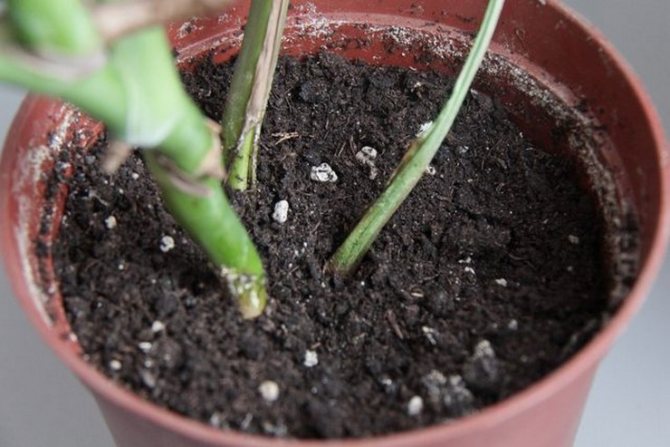

The flower container must be replaced with a larger one during each transplant, but not much. For the first three years, each new pot needs to be increased by about 10-15 cm, and later even by 20 cm. If the container for the flower is very large in size, then the soil may acidify or will gradually turn into a swamp.
Bulky adult plants are planted in specially selected or made tubs made of wood. Mature specimens of monstera cannot be transplanted alone, as they have a large mass and can be easily damaged. Experienced flower growers recommend that this procedure be carried out by at least two people.
The monstera is transplanted by the transshipment method. For easier removal of the flower from the container, you must first water the plant abundantly and leave it for a while to completely moisten the soil. Then you need to carefully tilt the flower pot on its side, cut off the roots that have sprouted into the drainage holes and pull the flower out by the base of the trunk.
The bottom of the new flower container must first be covered with a drainage layer. For this, any material is suitable that will not allow stagnation of water in the ground (for example, broken brick or tile, expanded clay or river pebbles). On top of the drainage, it is necessary to pour a small layer of soil and install a plant with an earthen clod on it. The root part must be carefully spread over the entire surface of the soil, and then fill the container to the top with prepared earth, gradually tamping it. It is very important that the root collar does not sink below the usual level at which it was in the previous flower pot.
You need to finish planting with abundant watering until water appears in the pan. When the soil mixture dries up, you can water it in the future in the usual volumes and frequency.
How to transplant to a monster with aerial roots
Adult vines have an amazing character: the larger the volume of their pot, the larger they grow. For a large monstera, you have to take an extensive pot, "for growth", which should be eight to ten centimeters larger in diameter than the previous one.Before transplanting to a monster, you should take care of the support in advance, which will need to be installed immediately. Alone, moving a tall plant to another pot will not work, so you need to take someone as an assistant.
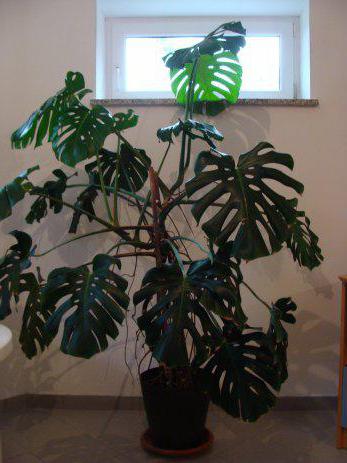

Before transplanting, the monster needs to be well watered, so that the ground is completely wet and the roots become elastic. Then you need to prepare and disinfect the soil mixture. A drainage layer should be poured onto the bottom of the pot and a support should be installed in it. Then you will need to get the monster along with an earthen lump from an old container. To do this, it is better to draw with a knife or spatula along its inner part, separating the adherent roots, and trim those that have grown into the drainage. It is optimal to stand on a chair and hold the monster while the assistant takes it out of the pot. Then the plant should be transferred to a new planter, set in the center and gradually fill the space between the stem and the walls with soil. Then the soil around the circle needs to be watered, wait until it settles, and add the rest of the earth.
Features of seasonal care
Note to flower growers:
- Spring. Transplanting into a new flowerpot, propagation by cuttings, moderate watering, growing in a warm room. The beginning of active growth of leaves and shoots;
- summer. Abundant watering, warmth in the room, good lighting, transplant into a new flowerpot. Monstera grows well, green mass is gaining volume;
- fall. A dormant period begins, but the leaves do not fall, although growth slows down. Watering is more rare, rather weak. Moving the flowerpot to a cool room, but indicators below + 16 ° C have a bad effect on the plant;
- winter. The flower rests, the leaf plates are preserved. The conditions of detention are the same as in the fall. Dampness and drafts should not be allowed in the room: black and gray bloom appears, leaves wither, and fungal diseases may develop.
Tips for florists from colleagues in the shop
It happens that when caring for a monster, no matter how unpretentious it is, novice florists have problems.
Here are the most common ones and measures to fix them:
- At the monstera leaves turn yellow... You cannot deprive a beauty of her main dignity - luxurious leaves. But how can I help her? Perhaps the soil in the pot is waterlogged. To remedy the situation, it is enough to reduce the frequency of watering or reduce the amount of water poured out. But if the leaves not only turn yellow, but also become covered with brown spots, watering, on the contrary, should be increased. This sign symbolizes a lack of moisture in the soil. Be careful not to confuse too much water with a lack of water.
- The plant has translucent yellow leaves... So the monstrous beauty says that there is too much light for her. You can solve the problem by simply rearranging the pot.
- Leaves are not completely cut, the stem is bare... This happens when there is a lack of light. Remember that the ideal conditions for this green friend are partial shade.
- At the monster dry tips... Excessive dryness of the indoor air can lead to such consequences. This, by the way, is harmful not only for plants, but also for humans, especially if you spend a lot of time at the computer. Therefore, place a vessel with water in the room with the flower or provide additional humidification in some other way. And say thank you to the plant for the timely signal.
- The plant has brown leaves... Do not forget to reduce the degree of soil moisture as the air temperature drops. Then the leaves will be fresh and green.
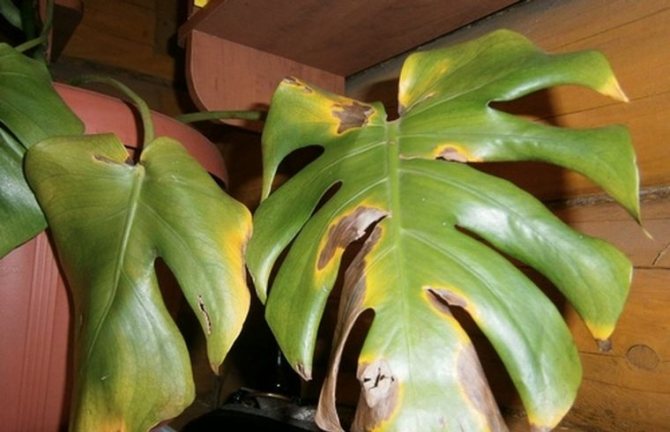

Florist experience:
How to reproduce a "monster"?
Monstera is really very popular, so be prepared for the fact that soon you will be asked to give an offshoot of this miracle, or you yourself will want to increase the number of "monsters" in your apartment. This is very easy to do.
Reproduction of monstera by cuttings or aerial roots follows the same, completely simple, scenario:
- separate the lateral process or aerial root from the plant;
- cover the fresh cut with charcoal and let it dry a little;
- plant the scion in a pot;
- cover it all on top with a glass jar to create a greenhouse environment;
- water your baby regularly;
- after the shoot has taken root, the jar can be removed.
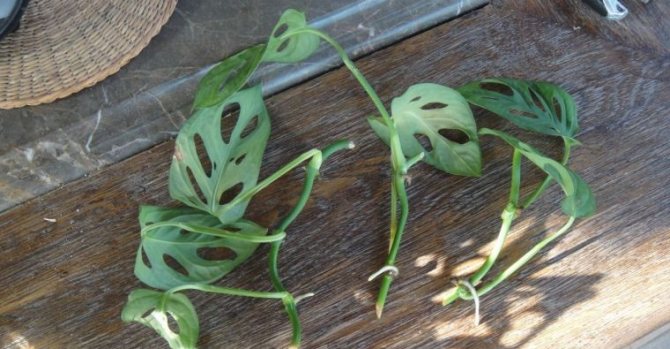

Plant cuttings
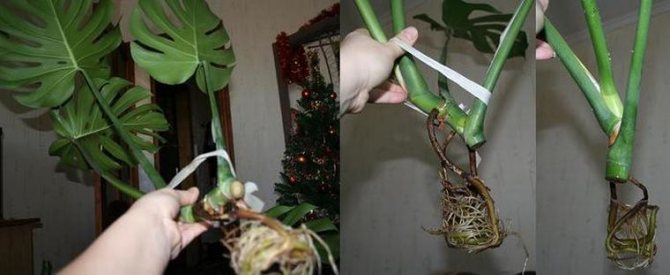

Reproduction of monstera by aerial roots is easy.
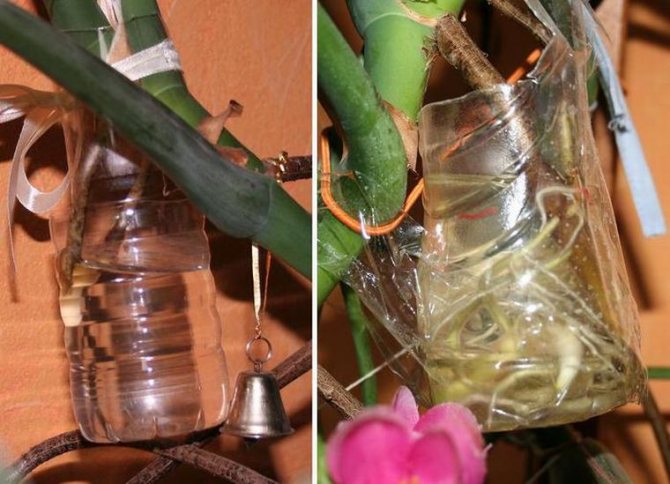

The plant has taken root
That's all! The operation is completed, you can dance and drink champagne. And it's not difficult at all, right?
Requirements for the composition of the soil
Under comfortable conditions, monsters grow quite quickly. For their planting, a light fertile soil mixture is used, the composition of which varies slightly depending on the age of the plant. For young lianas, the soil is used in equal amounts: turf and peat soils, humus and river sand. In this case, the recommended acidity (pH) should be 5.5–6.0.
Important! One of the main conditions when choosing a pot for a monstera is its stability. It is better to choose strong, rather weighty containers that cannot tip over from the weight of the leaves and stem.
For transplanting adult monsters, the following earthen composition should be used:
- sod soil - 3 units;
- peat soil - 1 unit;
- deciduous soil - 1 unit;
- river sand - 1 unit;
- humus - 1 unit.
The acidity of the soil mixture should be 6.5-7.0.
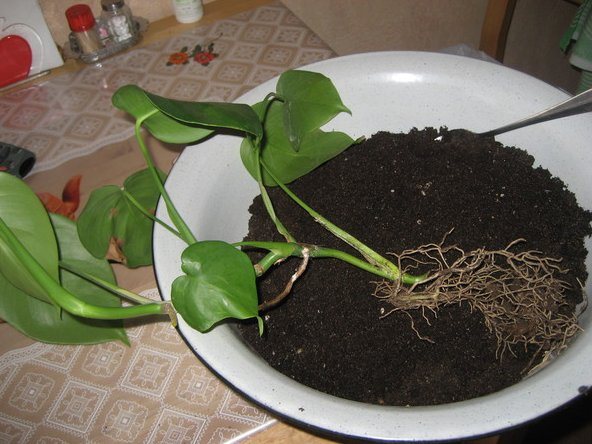

Plant properties
A huge liana with a monster-like name can prompt thoughts of harm by its appearance, but let's look at its properties.
Benefit
- The useful properties of a flower include:
- oxygen enrichment and moisture maintenance;
- the ability to absorb formaldehyde (some building materials emit it);
- ionization and purification of air using the substances it produces;
- collection of dust and work as a filter;
- interior improvement;
- use for shading;
- replacement of the barometer (before the rain, the leaves release droplets of moisture);
- absorption of electromagnetic radiation (it is recommended to place it near household and office equipment).
Harm and danger
Despite all the benefits, monstera is a poisonous plant.
- Therefore, it also has disadvantages:
- microscopic needles on the leaves secrete substances that irritate the mucous membranes if you touch them and then rub the mucous membranes of the eyes, nose or mouth;
- the sap of the plant is also poisonous, therefore, if ingested, it can provoke poisoning, which is characterized by numbness and swelling of the mouth and pharynx, loss of voice and dysphagia.
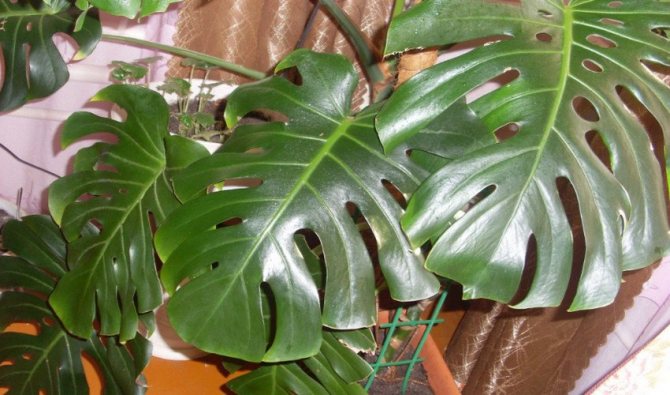

Many people attribute to liana the ability to take away energy or the fact that it absorbs a lot of oxygen, but this is all speculation.

